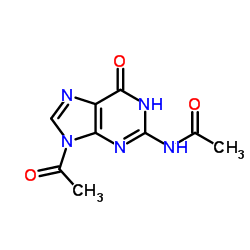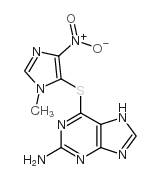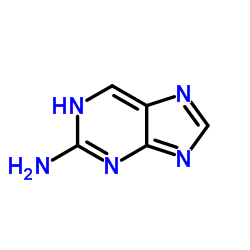6-Thioguanine

6-Thioguanine structure
|
Common Name | 6-Thioguanine | ||
|---|---|---|---|---|
| CAS Number | 154-42-7 | Molecular Weight | 167.192 | |
| Density | 2.1±0.1 g/cm3 | Boiling Point | 460.7±37.0 °C at 760 mmHg | |
| Molecular Formula | C5H5N5S | Melting Point | ≥300 °C(lit.) | |
| MSDS | Chinese USA | Flash Point | 232.4±26.5 °C | |
| Symbol |

GHS06 |
Signal Word | Danger | |
Use of 6-Thioguanine6-Thioguanine is an anti-leukemia and immunosuppressant agent, acts as an inhibitor of SARS and MERS coronavirus papain-like proteases (PLpros) and also potently inhibits USP2 activity, with IC50s of 25 μM and 40 μM for Plpros and recombinant human USP2, respectively. |
| Name | tioguanine |
|---|---|
| Synonym | More Synonyms |
| Description | 6-Thioguanine is an anti-leukemia and immunosuppressant agent, acts as an inhibitor of SARS and MERS coronavirus papain-like proteases (PLpros) and also potently inhibits USP2 activity, with IC50s of 25 μM and 40 μM for Plpros and recombinant human USP2, respectively. |
|---|---|
| Related Catalog | |
| Target |
IC50: 25 μM (PLpros), 40 μM (Recombinant human USP2)[3] |
| In Vitro | 6-Thioguanine is an anti-leukemia and immunosuppressant agent, acts as an inhibitor of SARS and MERS coronavirus papain-like proteases (PLpros) and also potently inhibits USP2 activity, with IC50s of 25 μM and 40 μM for Plpros and recombinant human USP2, respectively[1]. 6-Thioguanine affects the methylation of cytosine residues by purified DNA methyltransferases including human DNMT1 and bacterial HpaII methylase. 6-Thioguanine (1 or 3 μM) decreases global cytosine methylation in Jurkat T cells and cytosine methylation in human cells at 3 μM[2]. 6-Thioguanine (18.75, 37.50, or 75.00 μM) adversely affects cell viability, but with no effect on LDH or ALT activity[3]. |
| Cell Assay | Treatments consists of 3 thiopurines (azathioprine, 6-mercaptopurine, and 6-thioguanine) at each of 6 concentrations (0.468, 0.937, 1.875, 3.750, 7.500, and 15.000 μM). Each thiopurinee is dissolved in DMSO solution to achieve a concentration of 10 mg/mL. Sterile filtered maintenance medium is used to further dilute each thiopurine solution to each of the 6 treatment concentrations. Twenty-four hours after the hepatocytes are plated on 96-well culture[3]. |
| References |
| Density | 2.1±0.1 g/cm3 |
|---|---|
| Boiling Point | 460.7±37.0 °C at 760 mmHg |
| Melting Point | ≥300 °C(lit.) |
| Molecular Formula | C5H5N5S |
| Molecular Weight | 167.192 |
| Flash Point | 232.4±26.5 °C |
| Exact Mass | 167.026566 |
| PSA | 119.28000 |
| LogP | -0.99 |
| Vapour Pressure | 0.0±1.1 mmHg at 25°C |
| Index of Refraction | 2.071 |
| Water Solubility | soluble |
CHEMICAL IDENTIFICATION
HEALTH HAZARD DATAACUTE TOXICITY DATA
MUTATION DATA
|
| Symbol |

GHS06 |
|---|---|
| Signal Word | Danger |
| Hazard Statements | H301 |
| Precautionary Statements | P301 + P310 |
| Personal Protective Equipment | Eyeshields;Faceshields;Gloves;type P2 (EN 143) respirator cartridges |
| Hazard Codes | T:Toxic; |
| Risk Phrases | R25 |
| Safety Phrases | S28-S36/37/39-S45-S28A |
| RIDADR | UN 2811 6.1/PG 3 |
| WGK Germany | 3 |
| RTECS | UP0740000 |
| Packaging Group | III |
| Hazard Class | 6.1 |
| HS Code | 2933990090 |
|
~78% 
6-Thioguanine CAS#:154-42-7 |
| Literature: Tomsons, U. A.; Avots, A. A.; Kolesnikova, I. A. Pharmaceutical Chemistry Journal, 1985 , vol. 19, # 2 p. 136 - 138 Khimiko-Farmatsevticheskii Zhurnal, 1985 , vol. 19, # 2 p. 206 - 209 |
|
~% 
6-Thioguanine CAS#:154-42-7 |
| Literature: Pharmaceutical Chemistry Journal, , vol. 19, # 2 p. 136 - 138 Khimiko-Farmatsevticheskii Zhurnal, , vol. 19, # 2 p. 206 - 209 |
| HS Code | 2933990090 |
|---|---|
| Summary | 2933990090. heterocyclic compounds with nitrogen hetero-atom(s) only. VAT:17.0%. Tax rebate rate:13.0%. . MFN tariff:6.5%. General tariff:20.0% |
|
Cheminformatics analysis of assertions mined from literature that describe drug-induced liver injury in different species.
Chem. Res. Toxicol. 23 , 171-83, (2010) Drug-induced liver injury is one of the main causes of drug attrition. The ability to predict the liver effects of drug candidates from their chemical structures is critical to help guide experimental... |
|
|
Translating clinical findings into knowledge in drug safety evaluation--drug induced liver injury prediction system (DILIps).
J. Sci. Ind. Res. 65(10) , 808, (2006) Drug-induced liver injury (DILI) is a significant concern in drug development due to the poor concordance between preclinical and clinical findings of liver toxicity. We hypothesized that the DILI typ... |
|
|
Developing structure-activity relationships for the prediction of hepatotoxicity.
Chem. Res. Toxicol. 23 , 1215-22, (2010) Drug-induced liver injury is a major issue of concern and has led to the withdrawal of a significant number of marketed drugs. An understanding of structure-activity relationships (SARs) of chemicals ... |
| MFCD00233553 |
| 2-Amino-6-methoxy purine |
| tabloid |
| 2-aminomercaptopurine |
| 2-amino-9H-purine-6(1H)-thione |
| tioguanin |
| 2-Amino-6-purinethiol |
| bw5071 |
| Tioguanine |
| 2-Amino-6-mercaptopurine,2-Amino-6-purinethiol |
| 7H-Purine-6-thiol, 2-amino- |
| 2-Amino-6-mercaptopurine |
| 2-Amino-1H-purine-6(7H)-thione |
| 6-Thioguanine |
| lanvis |
| Tg |
| 6-tg |
| thioguanine |
| thio-guanin |
| 6-thioguanidine |
| EINECS 205-827-2 |
| wellcomeu3b |
| 2-Amino-1,7-dihydro-6H-purine-6-thione |
| 6-Mercaptoguanine |


 CAS#:5581-52-2
CAS#:5581-52-2 CAS#:452-06-2
CAS#:452-06-2![2-[(2-amino-5H-purin-6-yl)sulfanyl]acetamide structure](https://image.chemsrc.com/caspic/397/89853-37-2.png) CAS#:89853-37-2
CAS#:89853-37-2![Acetic acid,2-[(2-amino-9-propyl-9H-purin-6-yl)thio]- structure](https://image.chemsrc.com/caspic/135/42204-31-9.png) CAS#:42204-31-9
CAS#:42204-31-9
